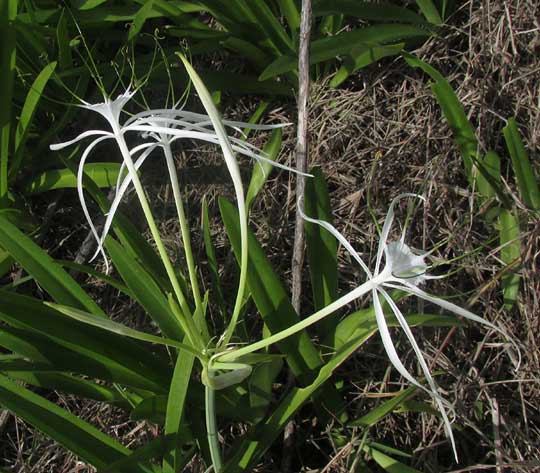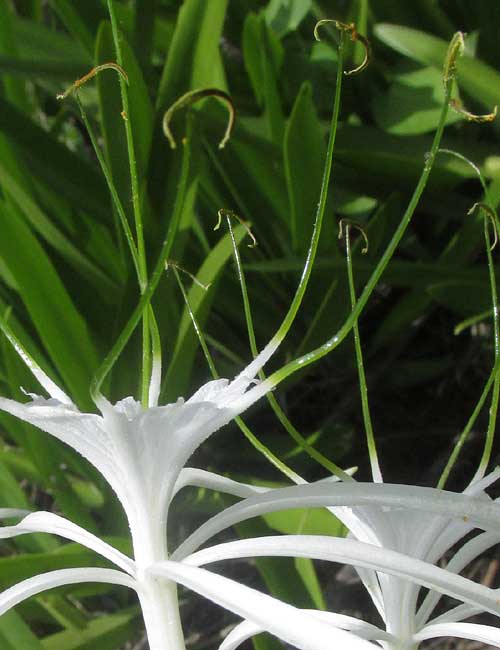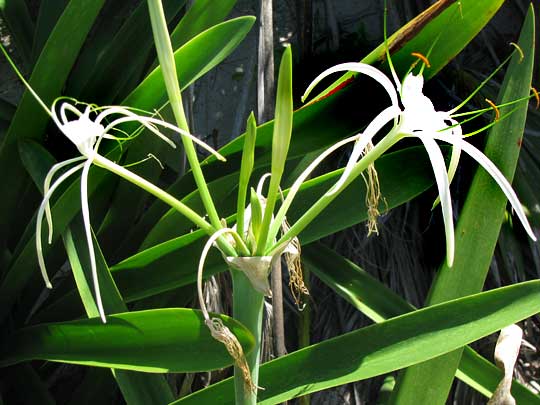Excerpts from Jim Conrad's
Naturalist Newsletter
from the July 12, 2015 Newsletter issued from Río Lagartos, on the Yucatan Peninsula's northern coast (~N21.60°, ~W88.16°), Yucatán state, MÉXICO
BEACH SPIDERLILIES NOT ON BEACHES
In low areas on sandy beaches of the Yucatan Peninsula's Caribbean coast we've often admired Beach Spiderlilies, HYMENOCALLIS LITTORALIS, which spectacularly flower at this time of year. The species is fairly common in such coastal habitats throughout most of the tropical Americas, and because of its beauty often is planted elsewhere.
Here our Beach Spiderlilies mainly grow away from sandy beaches, in standing water or swampy mud. A typical grouping is shown below:

A closer look at a cluster of flowers atop their long stem, or scape, is shown below:

An even closer look at how the stamens' green filaments are topped with horseshoe-shaped anthers is below:

In that picture, notice how the stamens arise not from the main corolla, but rather from a funnel-shaped extension of the corolla issuing from where the corolla's petal-like lobes come together. The funnel-shaped thing is a special feature of spiderlilies, called the crown or "staminal cup." Several lily-type flowers possess crowns, maybe the most familiar being the daffodil. In our picture, the staminal cup is almost exactly one inch high (2.5cm).
Most amarylis-type plants like our Beach Spiderlily contain toxic compounds. That's the case with this species, whose juices have long been known to be antimicrobial, and thus used in various ways in traditional medicine. In particular the plant is used for skin infections, rheumatic pains, fevers and missed menstrual periods.
from the December 22, 2008 Newsletter issued from Mayan Beach Garden Inn on the osta Maya, Quintana Roo, MÉXICO
BEACH SPIDERLILY
Several plants with large blossoms with slender petals and/or long-exerted stamens are called "spider lily." Back in Mississippi a red-flowered plant blossoming in late July and early August, Lycoris radiata, of the Amaryllis Family, is the main "spider lily." Back home in Kentucky the main wild "spider lily," also a member of the Amaryllis Family, is Hymenocallis occidentalis.
Down here one of the most spectacular as well as most commonly encountered plants on the sandy ridge separating the ocean from the mangroves is a "spider lily" with flowers very similar to the white Kentucky species. In fact, it's in the same genus. It's HYMENOCALLIS LITTORALIS, often known in English as the Beach Spiderlily. A cluster of blossoms standing guard outside my tent door recently is shown below:

In the picture notice the conspicuous "staminal cup" -- the flaring, white, cuplike "crown" from which the stamens arise, growing inside and a little above the long, slender, white, recurving, petal-like items. The staminal crown is a distinctive feature of several closely related genera in the Amaryllis Family, such as Narcissus and our Mississippi Lycoris. You can recognize the stamens by their brown, curved, pollen-producing anthers attached by the centers of their backs to long, stiff, greenish filaments arising from the staminal cup's rim.